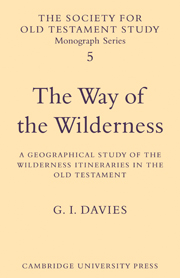Book contents
- Frontmatter
- Contents
- Preface
- Abbreviations
- Maps
- 1 Introduction
- 2 Jewish interpretations in Greek
- 3 Jewish interpretations in Hebrew and Aramaic
- 4 Christian interpretations
- 5 Arabic interpretations
- 6 Behind the traditions
- 7 Key points on the routes
- 8 Routes in the Sinai Peninsula
- 9 Identification of the routes described
- Notes to the text
- Bibliography and Author Index
- Indexes
3 - Jewish interpretations in Hebrew and Aramaic
Published online by Cambridge University Press: 04 August 2010
- Frontmatter
- Contents
- Preface
- Abbreviations
- Maps
- 1 Introduction
- 2 Jewish interpretations in Greek
- 3 Jewish interpretations in Hebrew and Aramaic
- 4 Christian interpretations
- 5 Arabic interpretations
- 6 Behind the traditions
- 7 Key points on the routes
- 8 Routes in the Sinai Peninsula
- 9 Identification of the routes described
- Notes to the text
- Bibliography and Author Index
- Indexes
Summary
At first glance the Hebrew and Aramaic texts appear to be unpromising material for a geographical inquiry such as this. Where there is any interest at all in the itineraries and the names that appear in them, the approach is generally that of the etymologising midrash. This kind of interpretation, which could find some justification in the Old Testament itself (cf. Ex. 17: 7; Num. 11:3, 34), deduces from a name something about the early history of Israel, assuming that the name was conferred on the place because of a specific occurrence in Israel's past. Even where this kind of exegesis is not present, the overall interest of the translators and commentators seems to be in non-geographical aspects of the Biblical text, either the harmonising of apparently contradictory accounts or the extracting of a universal halakhic principle from it. Yet such ‘spiritualising’ interpretations are not the whole of what these exegetes had to say about the text. There are some indications of an interest in geographical questions in the treatment of the itineraries. Unfortunately this most often happens in the Targumim, where the identifications are anonymous and there is often no sure way of distinguishing an early interpretation from a comparatively late one. In a few cases, where a tradition is attested elsewhere, it is possible to affirm that it originated in or before the Tannaitic period, for example.
- Type
- Chapter
- Information
- The Way of the WildernessA Geographical Study of the Wilderness Itineraries in the Old Testament, pp. 14 - 29Publisher: Cambridge University PressPrint publication year: 1979



